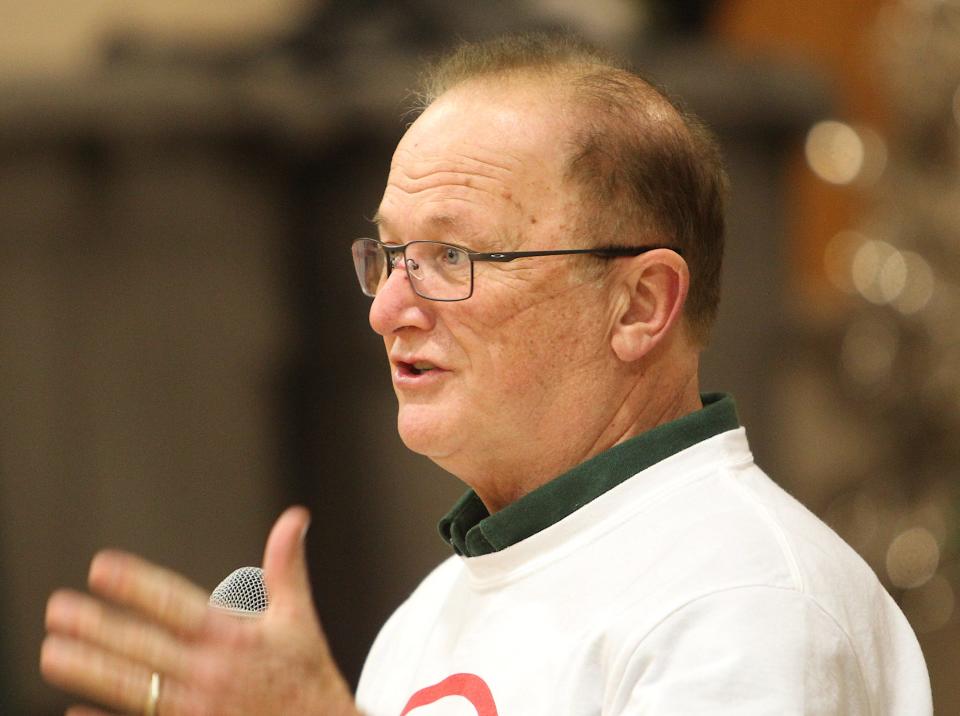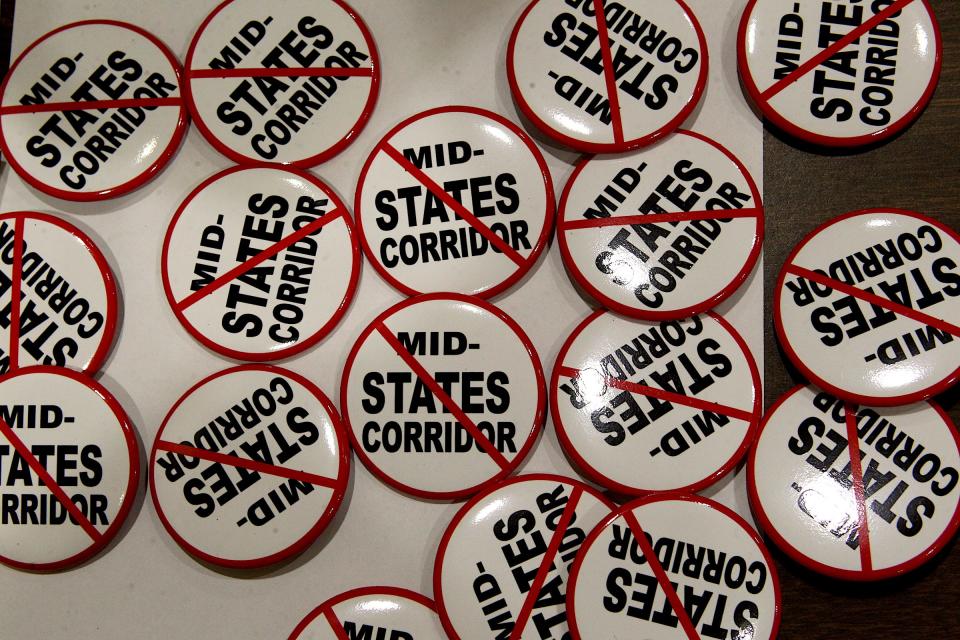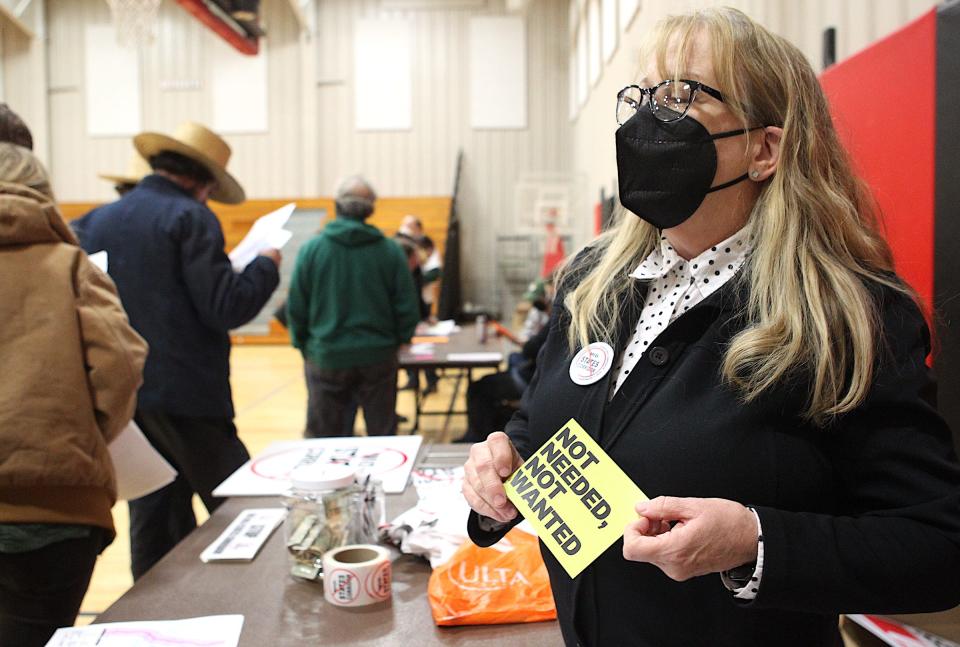As Southern Indiana explores new way of financing major highway, residents are wary
In Mayor Noel Harty's decade of attending public meetings in the Southern Indiana city of Loogootee, population 2,600, hardly anyone has ever shown up.
But in early 2020, a discussion of one highway project left standing room only in the Loogootee High School auditorium, which seats 600.
"And that was before the route was chosen," he said.
The kind of project they came out in droves to hear about is equally rare.
The Mid-States Corridor is a proposed 50-mile highway roughly following U.S. 231 with cost estimates near $1 billion, built for the express purpose of boosting economic activity in Southern Indiana. The only other comparable endeavor in the area in recent living memory is the I-69 project.
For subscribers: Affordable housing in HamCo now problem for 'most income groups'.
It's also rare because, if approved, it would be the first time Indiana has used a new method of funding major highways, created by a 2017 law.
That law authorizes a Regional Development Authority — a public entity spanning multiple cities or counties whose appointed board helps plan and fund economic development projects — to directly leverage federal funding for regional transportation infrastructure projects, such as the Mid-States Corridor, which affects a 12-county region.
To get this process rolling, the RDA behind the Mid-States — rather than state agencies like INDOT, which typically initiates projects of this scale — raised money to pay for a thick federally required environmental study, which published this spring.
Local entities commonly seek federal grants to fund projects. This legislation grants the power to a collaboration of entities — the multiple local governments that formed the RDA, whose funding may come from a combination of public and private dollars — to seek federal money and partner with the state on regional highway projects, therefore expanding the RDA's ability to finance large-scale projects and leverage private dollars.

To industry leaders in Southern Indiana, the highway is a crucial means of reducing travel time to business centers and presenting a lifeline to a region that's losing population and needs better connectivity for jobs. To critics, it's an example of business leaders pitching their dollars toward a huge project that benefits them, at the expense of more than 1,000 acres of farmland, karst and cave areas and up to 100 homes.
At a Huntingburg city council meeting in February, Mark Schroeder, chair of the Mid-States Corridor RDA, told councilors he believes this partnership could be a model for future infrastructure projects.
Watching on YouTube, Mark Nowotarski, active in the Coalition Against the Mid-States Corridor, thought to himself, "What will be next?"
Origins of the Mid-States Corridor
The U.S. 231 corridor has been studied off and on since the 1990s.
In 1993, the Indiana Department of Transportation commissioned a study to identify ways to improve traffic service and capacity on the road within Dubois County, in the areas of Jasper and Huntingburg. The study came up with some bypass ideas, but none came to fruition.
In 2004, INDOT approved a draft Environmental Impact Statement — a federally required document investigating a project's costs and impacts to land and resources — for the same 20-mile span of U.S. 231.
More: When could Indiana see gas prices in the $3 range again? It could be years, expert says
Doing nothing on this road would have fewer environmental impacts, the 2004 study noted, but would not be consistent with "the intended function of U.S. 231 as a regional mobility corridor and a commerce corridor."
A final Environmental Impact Statement was never approved or published. In early 2010, INDOT and the Federal Highway Administration decided to update the 2004 data in a new statement published in 2011.
In 2014, the federal government withdrew both the 2004 and 2011 studies, saying the project is "no longer warranted" after reevaluating the traffic information, according to the Federal Register notice.
But the effort to build a new highway only expanded.
The I-67 Development Corporation, a coalition of business leaders and elected officials, commissioned a feasibility study in 2012 of an interstate project that would connect Nashville to western Michigan, with one section spanning what is roughly now the proposed 50-mile Mid-States: starting at I-64, bypassing Huntingburg and Jasper to the east, and tying into I-69.
Cambridge Systematics, the author, interviewed industrial leaders to determine their transportation connection needs to improve freight movement in the region, arguing that an efficient network is essential to keeping Indiana competitive. The study specifically called out the benefits for companies like Jasper Engines and furniture manufacturers in the area.

In 2014, the I-67 corporation renamed that southern Indiana portion the Mid-States Corridor. Several corporation members — including Hank Menke, CEO of Huntingburg-based furniture manufacturer OFS Brands, and then-Lt. Gov. Sue Ellspermann — also participated in former Gov. Mike Pence's Blue Ribbon Panel on Transportation Infrastructure, which named the Mid-States Corridor a second-tier priority for the state.
But projects don't actually get built without the say-so of the state and federal transportation agencies.
Sen. Mark Messmer, R-Jasper, who is vice president of Jasper-based plumbing company Messmer Mechanics, authored Senate Bill 128, which became the law allowing an RDA to apply for federal money and partner with INDOT on funding regional transportation infrastructure projects.
Through a spokesperson, Messmer declined IndyStar's request for comment.
Dubois and Spencer counties and the cities of Jasper and Huntingburg formed the Mid-States Corridor RDA in 2017. The RDA struck up an agreement with INDOT in 2018 to embark on the environmental impact study process, a requirement of the National Environmental Policy Act for projects expected to use federal dollars and have significant impacts to land and resources. INDOT contracted civil engineering consultant Lochmeuller Group to put together the draft Environmental Impact Statement, or DEIS, which published in April.
The study identifies two main purposes for the highway: to improve business and personal connectivity in the region, and to improve highway access to multi-modal business locations such as Indianapolis and Louisville. Relieving congestion in Dubois County, a key purpose of previous U.S. 231 studies, is now a secondary goal for the Mid-States.
'Complete Streets' 2.0: Eyeing safety, Indianapolis revises 10-year-old road design policy
The preferred route identified in the study would save an estimated 2-5 minutes in travel time to most destinations, with the greatest savings of 9-15 minutes from the Crane Naval Surface Warfare Center to Rockport. Business leaders interviewed for the study identified highway access, unpredictable delivery times and increased freight costs as key inhibitors to business growth and attraction, in a region where population growth has for decades lagged behind the state and nation.
The study projects an annual growth in the region's gross domestic product by somewhere between $314 million and $451 million and an increase of between 1,700 and 2,500 jobs, at the expense of potentially 600 to 900 acres of forest, 1,400 to 1,800 acres of farmland and 75 to 100 homes.
While acknowledging farmland as an important resource, the study says the economic benefits of the highway would "more than compensate for these impacts," through better market access and reduced transportation costs for supplies.
The calculation feels different for David Ring, fifth-generation owner of Ring Farms in Dubois County. Based on the map of the preferred route, his 140-acre plot where he grows award-winning bushels of corn would be spliced in half. In a market where not many farmers are looking to sell, he doesn't see the land as replaceable.
“That’s our livelihood," he said. "That land is our factory."
Business involvement in public infrastructure projects
Though the Mid-States is the first example in the state of an RDA undertaking the federal highway study process, it's certainly not the first example of such stakeholders having heavy involvement.
All projects of this scale involve stakeholder and public engagement. Local public agencies frequently participate financially in projects.
What's different in the 2017 law is the ability for this regional body to apply directly to the largest source of money available, the federal government, to strengthen their purchasing power on projects impacting multiple counties, rather than relying on state distributions. The law also allows an RDA to seek low-interest loans from the Indiana Finance Authority.
"It’s a leverage point," said Tom Guevara, director of Indiana University's Public Policy Institute. "It’s a new financing arrow in their quiver."
This is especially significant as President Joe Biden's new infrastructure law is set to significantly increase available federal money over the next five years.
People keep dying in crashes on Indianapolis streets. What can actually be done about it?
"I do think it has the potential to be a vehicle of the future that kind of represents how local dollars may be a part of the mix," Schroeder, the RDA chairman, told IndyStar. "The involvement of locals allows the state to stretch their dollars farther."
The RDA mechanism certainly can help raise the profile of a project that wasn't previously on INDOT's radar, said Purdue University Professor Emeritus Kumares Sinha. Schroeder acknowledged that was likely the case with this project.
This may make more transparent what is a common stakeholder relationship, Sinha said.
"The idea is nothing new, and it is good the local areas are buying in in a more explicit way, putting their money where their mouth is," he said.
The project proposal for a U.S. 231 bypass around Jasper and Huntingburg appeared in INDOT's State Transportation Improvement Program for 2010-13, a four-year planning document outlining projects that the state plans to help fund. Planning documents since then have not programmed dollars to study the corridor.
The RDA raised $6.5 million in public and private dollars, including inputs from Dubois County and the cities of Jasper and Huntingburg, to pay for the draft EIS. Private donors contributed $3.7 million, including nearly half a million from Jasper Engines. The list of private donors, a copy of which was obtained and authenticated by IndyStar, is heavily redacted, as state law allows those who donate to public agencies to request nondisclosure.
This does not guarantee the project's completion.
"The EIS just signals that somebody is willing to spend hundreds of thousands of dollars studying it," said Michael Hicks, economics professor at Ball State University. "Which, for roads, is background noise."
As mandated by the National Environmental Policy Act, or NEPA, the draft EIS undergoes independent review by agencies like the Environmental Protection Agency, the U.S. Fish and Wildlife Service, the state historic preservation office, and others. The final decision on whether to proceed with the project comes from state and federal transportation officials.
From Evansville: Person who worked on Mid-States Corridor now opposes road
The fact that an RDA is the genesis of this project does not change that federally mandated process and criteria, Jason DuPont, Lochmeuller's project manager for the Mid-States Corridor, wrote via email.
Those transportation agencies know their decision must stand up to legal scrutiny, given that public dollars are at stake, said Ken Westlake, deputy director of the EPA's Office of Multimedia Programs.
"NEPA is intended to be a very transparent process," he said. "Ultimately INDOT and FHWA will have to stand behind their document."
Hicks similarly has confidence in the NEPA process, noting that the era of earmarks, which subjected public projects to the whims of powerful politicians, is long gone.
He has sat on independent EIS review teams, and said projects have to prove a broader economic benefit beyond the scope of just a few business interests to pass muster.
"It’s more bureaucratic now, but it introduces a very high level of scrutiny on the project that didn’t exist in the 1950s when many of these highways were built," he said. "If that road is just a benefit to somebody making wood products or shipping, it won’t get built. Because roads are expensive as all get-out."
Will the Mid-States get built?
Because of the size of the project, the funders decided to pursue a two-tier study. The first tier, published in April, gives a broad evaluation of the project's potential impacts. The second tier, yet unfunded, would get into specifics on smaller chunks of the project.
Each of those chunks could take years and cost about what the Tier 1 study cost, Schroeder said. No entity has committed dollars yet to Tier 2.
Generally, a project doesn't move to the end of the NEPA process unless there's an expectation it'll get funded, Westlake said. In the case of the Mid-States corridor, that could be in excess of $1 billion.
Key to the NEPA process is the public input, which independent reviewers are obligated to weigh. That public comment period, which ended June 14, was dissenters' best opportunity to have an impact.

Dozens of local businesses and environmental groups, including the Sierra Club and the Hoosier Environmental Council, penned a letter in 2020 urging INDOT to halt the planning of the project. The Coalition Against the Mid-States Corridor has written letters to INDOT and U.S. Secretary of Transportation Pete Buttigieg, marched around the Dubois County courthouse and hosted several crowded town halls.
They don't want any more taxpayer dollars allocated toward future studies of a project they view as unnecessary, Nowotarski, a Jasper resident, said.
"We're trying to plant seeds early," he said.
From 2020: Businesses, groups call on INDOT to stop planning highway project
Dissenters were dubious of the need for building new highway terrain when Gov. Eric Holcomb announced last year $75 million in improvements on U.S. 231 in the exact stretch of the proposed Mid-States.
"This project represents ridiculous extravagance and fiscal waste on the part of the political leaders supporting this project,” Indiana Forest Alliance Executive Director Jeff Stant said in a statement following the April release of the draft EIS. “There is zero need — unless you own a trucking company — to build a new-terrain road right beside 231 when the state has already committed $75 million to upgrade to 231.”
Those upgrades were considered in the crafting of the DEIS, according to the Mid-States Corridor website.
Schroeder pushes back against the claim that just a few freight companies benefit from the highway, noting the list of donors spans a variety of organizations and people.
"Clearly, there’s a fair amount of industry in Dubois County, and better connectivity would certainly benefit them," he said. "But I think everyone who donated understands that this is a long-term strategy."
Given the length of the review process, even a successful project is at minimum a decade away.
"There’s certainly a lot of review that goes on," said Tim Maloney, senior policy director for the Hoosier Environmental Council. "I guess we’re just more cynical."
Cynical, he said, of the objectivity of the premise of the project.
There's no denying the political nature to these major decisions, experts said.
"Everyone has a stake in it, everyone has an important argument to make," Guevara, of IU, said. "The question comes down to: whose argument do they give the greatest weight to?"
Ring, the farmer, is buoyed by the sea change in resident involvement he's observed over the last several years. Back then, when he tried to rile up his neighbors, he said he was often met with a jaded, it'll-happen-regardless attitude. But now, he's seeing a vocal contingent rising to meet his enthusiastic opposition.
"I think the momentum has shifted. Whether or not it’s enough, that’s the question," he said. "We’re not just laying down and dying."
Contact IndyStar transportation reporter Kayla Dwyer at kdwyer@indystar.com or follow her on Twitter @kayla_dwyer17.
This article originally appeared on Indianapolis Star: Mid-States Corridor proposal has residents wary, leaders excited

